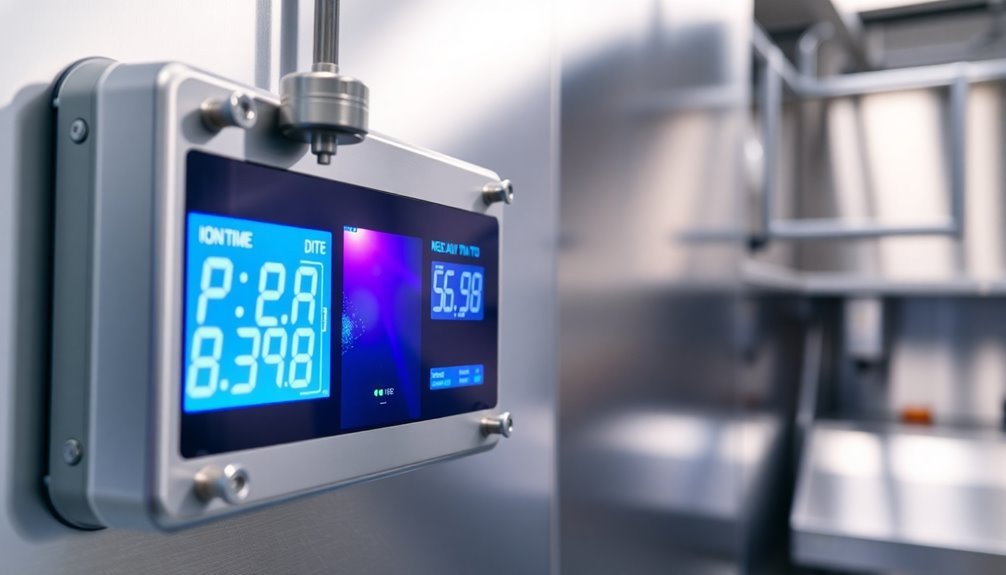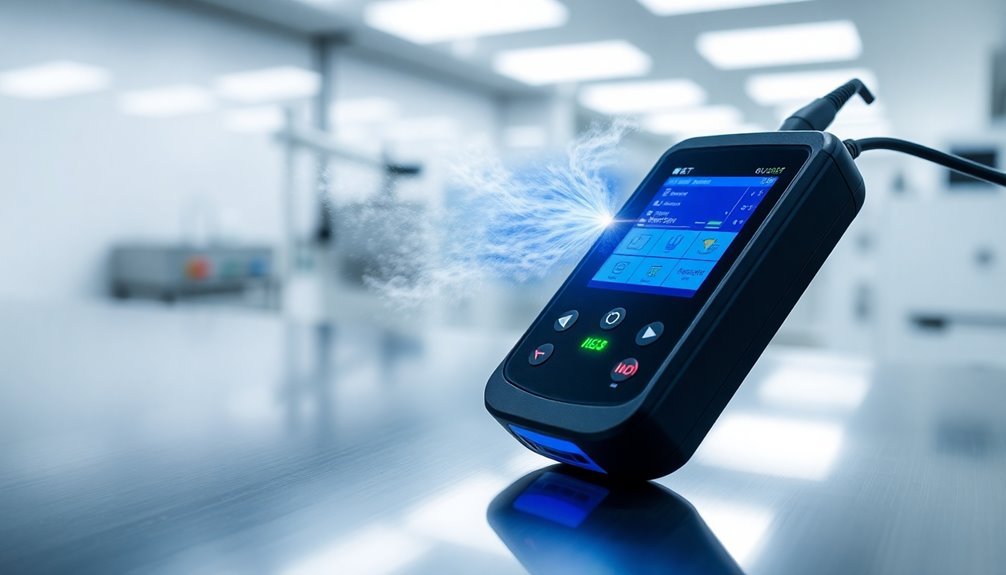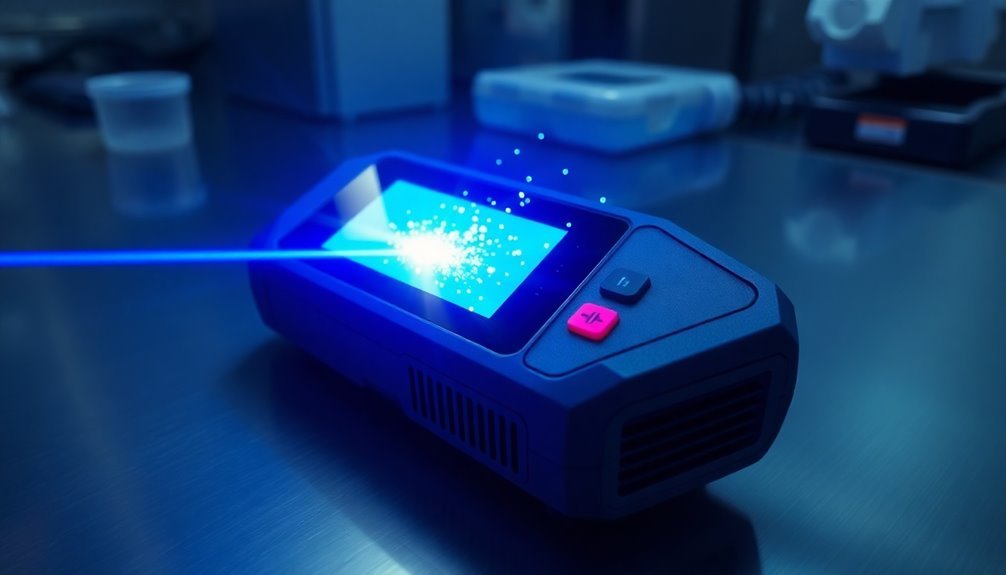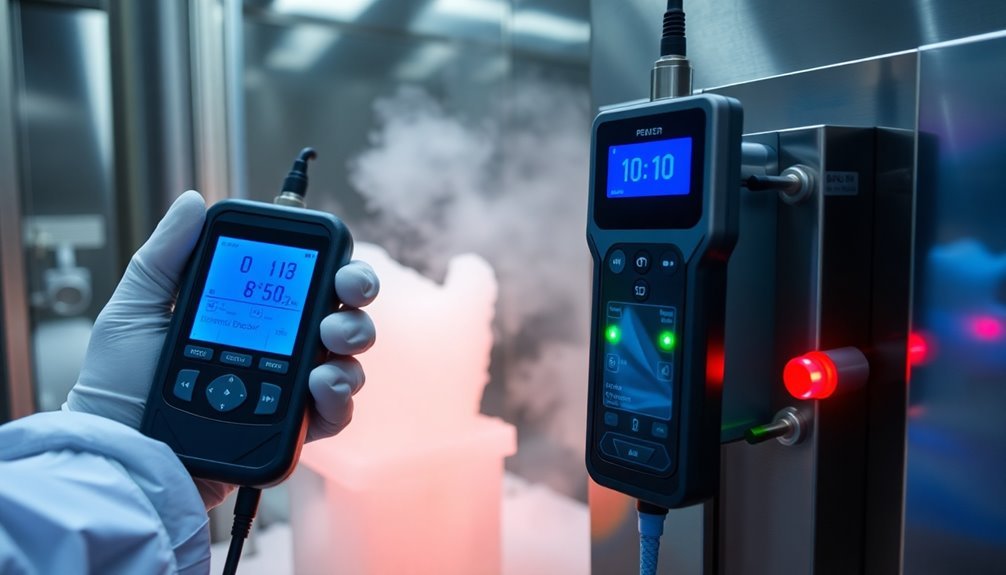Modern ionization monitoring methods use a combination of technologies to keep your environment clean and safe. You'll find systems that integrate corona discharge, UV light, and electrostatic mechanisms to generate and control ions effectively. These systems measure ion concentration, particle counts, and static charge levels through direct-reading instruments and multi-gas monitors. You can track air quality in real-time using smart technology with Bluetooth and Wi-Fi connectivity, while automated interfaces help maintain ideal conditions. Strategic placement of monitoring stations and proper safety protocols guarantee your space stays consistently clean. The world of ionization monitoring offers much more to explore.
Understanding Ionization Control Systems

While ionization technologies continue to evolve, understanding their control systems remains essential for effective air quality management. You'll find that modern ionization control systems integrate multiple technologies to monitor and adjust ion production based on environmental needs. These systems typically incorporate corona discharge, UV, or electrostatic mechanisms to generate ions effectively. Regular maintenance protocols help minimize potential issues and ensure optimal performance of these air purification systems.
You can expect these control systems to measure various parameters, including ion concentration, particle counts, and static charge levels. When you're working with industrial or medical applications, you'll notice that hybrid systems often provide the most thorough monitoring capabilities by combining different ionization methods. They'll automatically adjust their output to maintain ideal air quality levels.
As you implement these systems, you'll see how they're becoming increasingly integrated with smart technology. You can now monitor and control your ionization systems remotely through automated interfaces that provide real-time data on air quality metrics.
Whether you're managing a cleanroom or a medical facility, these control systems help you maintain precise environmental conditions by continuously monitoring ion levels and adjusting their output to neutralize contaminants effectively.
Air Quality Measurement Tools
Several essential tools form the backbone of modern air quality measurement systems. You'll find direct-reading instruments that provide immediate data alongside particulate monitors using aerosol photometers to detect scattered light. Multi-gas monitors and portable gas chromatographs like the FROG-5000 help you measure various pollutants, including volatile organic compounds in air, soil, and water.
These instruments come equipped with advanced features you'll need for thorough monitoring. You can rely on Bluetooth Low Energy and Wi-Fi connectivity to transmit data efficiently, while battery-powered devices offer up to 10 days of continuous operation. The modular sensors let you customize your monitoring setup based on specific requirements. For comprehensive indoor monitoring, devices can track key environmental parameters like CO2, formaldehyde, and TVOCs simultaneously.
You'll need to follow regulatory guidelines when implementing these tools. Your ambient air quality networks should include both background and residential locations, measuring parameters like SPM, PM10, RSPM, PM2.5, SO2, NOx, and CO.
These tools support various applications, from indoor air quality assessment in commercial buildings to industrial hygiene monitoring. They're particularly useful for tracking environmental conditions, ensuring HVAC effectiveness, and maintaining compliance with green building standards through real-time alerts and historical data analysis.
Bipolar Ion Generation Methods

To understand bipolar ion generation effectively, you'll want to start with Corona Discharge Technology, which uses high-voltage electricity through conductive needles or metal plates to create ions.
While Corona Discharge remains widely used in commercial HVAC systems, you'll need to take into account its drawback of potential ozone production.
Brush-Type Discharge technology offers a lower-voltage alternative using fiber brushes for ion generation.
UV-based ion production offers an alternative method, though it's less common in modern applications due to higher energy requirements and maintenance needs.
Corona Discharge Technology Basics
The corona discharge method harnesses high-voltage electricity to generate both positive and negative ions through a controlled ionization process. You'll find this technology operating between 5,000 and 20,000 volts, using either conductive needles or metal plates to create an electrical field that ionizes the surrounding air. The process breaks down oxygen molecules into their atomic form, enabling them to bond with the ends of molecules in treated materials. The ionization process creates a distinctive bluish-purple curtain visible during operation.
| Feature | Specification | Application |
|---|---|---|
| Voltage Range | 5K-20K V | Surface Treatment |
| Frequency | 20-60 kHz | Ion Generation |
| Environment | Atmospheric Pressure | Industrial Processing |
| Treatment Type | Surface Modification | Adhesion Enhancement |
When you're working with corona discharge systems, you'll notice they're particularly effective in manufacturing environments, especially for semiconductor packaging and plastics processing. The technology excels at modifying surface properties by increasing surface energy, which improves adhesion capabilities. You can apply this treatment to various materials, including fluoroplastics, natural fibers, and polymers like LDPE and PP. The process operates at atmospheric pressure using reactive gases such as air, oxygen, or nitrogen, making it a practical choice for industrial applications.
UV-Based Ion Production
While corona discharge systems rely on high-voltage electricity, UV-based ion production offers a different approach to ionization through vacuum ultraviolet (VUV) light. When you're using VUV technology, specialized lamps emit photons at specific wavelengths (124 nm and 117 nm), corresponding to energies of 10 and 10.6 eV. These photons selectively ionize molecules with ionization energies below these thresholds, such as methyl iodide and ammonia.
You'll find that VUV ion production provides several advantages over traditional methods. It's a "soft" ionization technique that minimizes fragment ions and sputtering, resulting in cleaner primary ion spectra and reduced background interference. The system can achieve impressive sensitivities of around 700 cps/ppt and detection limits as low as 0.05 ppt. The technology has been successfully integrated into Vocus Aim instruments for enhanced analytical capabilities.
In environmental applications, you can deploy VUV ion sources in field campaigns and aircraft, as they're robust and reliable at low pressures (2-10 mbar). Unlike bipolar ionization methods using corona discharge, VUV doesn't create electrical fields or produce hydroxyl radicals.
Instead, it uses a krypton lamp for targeted molecular ionization, making it particularly effective for detecting trace gases and volatile organic compounds.
Setting Up Monitoring Stations
You'll need to strategically position your monitoring equipment near ion generators while ensuring each station has reliable power access and proper grounding.
Set up data collection checkpoints at varying distances from the ionization source to measure ion concentration decay rates and establish baseline readings before activation. Testing sessions should run for a minimum of two hours duration to obtain accurate measurements.
Your monitoring layout should include both AHU-proximate and space-level measurement points to track ion distribution throughout the system.
Equipment Layout and Placement
Properly positioning ionization monitoring equipment requires careful attention to both strategic placement and specific measurement considerations. You'll need to install monitors within the breathing zone, typically 3-6 feet above the floor where occupants spend most of their time. Keep devices at least 3.3 feet away from windows, air filters, and diffusers to guarantee accurate readings. This setup is vital since indoor air pollutants can trigger respiratory issues and other health concerns.
| Element | Placement Distance | Key Consideration |
|---|---|---|
| Windows | 5m minimum | Avoid direct drafts |
| Air Returns | Closer proximity | Better readings |
| Workstations | 0.9m minimum | Occupant comfort |
| Air Diffusers | 1m minimum | Prevent interference |
| Room Corners | Avoid completely | Air stagnation |
For bipolar ionization equipment, you'll want to mount devices in the air handling unit or near spaces requiring treatment. Each monitor should cover approximately 3,500 square feet of space. When planning your layout, consider spreading sensors throughout the area to achieve thorough coverage. Don't forget to measure air quality before and after installation to verify effectiveness. If you're dealing with space constraints, position monitors closer to air returns than diffusers, and always maintain proper distance from doors and operable windows.
Data Collection Checkpoints
Building on proper equipment layout, the next step involves establishing strategic data collection checkpoints throughout your monitoring network. You'll need to implement four key monitoring components to guarantee thorough data collection and analysis.
Start with air quality monitoring equipment, confirming proper calibration and placement according to EPA guidelines. You'll want to integrate these monitors with your HVAC system while implementing robust data logging procedures. Implementing data validation techniques during collection helps ensure measurement accuracy.
Next, focus on ion concentration measurement by installing ion counters at predetermined intervals and standardizing your data collection methods to account for environmental interference.
You should conduct location-specific monitoring by evaluating each room individually and adjusting ionizers based on unique spatial requirements and airflow patterns. Don't forget to maintain regular inspection schedules to uphold consistent performance.
Finally, establish a network-based monitoring system that connects all your sensors to a centralized platform. This allows you to set up automatic alerts when levels fall below acceptable thresholds and enables data analytics for trend identification.
Power Supply Considerations
For reliable ionization monitoring, setting up proper power supply systems forms the foundation of your monitoring station network.
You'll need to carefully select power supplies that offer both constant current and voltage modes, along with remote sensing capabilities to compensate for wiring losses. Your setup should include proper isolation between channels to prevent ground loops and guarantee accurate measurements.
When choosing power supplies for your monitoring stations, you'll want to take into account transient response specifications, as these directly impact your measurement times.
Make sure you've included output disconnect relays to isolate your instruments from the device under test. If you need extended voltage or current ranges, you can cascade power supplies, but you'll need to verify isolation specifications first.
You can integrate your power supplies with sensors using RS-232 ports and implement PID control loops for automated regulation.
Use DAQmx or DAQ Assistant to read analog inputs from your sensors, and don't forget to include proper signal conditioning for accurate readings.
Think about implementing a producer/consumer architecture to effectively coordinate your sensors and power supplies, guaranteeing synchronized operation across your monitoring network.
Real-Time Data Collection Techniques

Scientists' ability to collect real-time ionization data has dramatically improved with the advent of Direct Analysis in Real Time (DART) Mass Spectrometry.
You'll find this technology enables rapid analysis of samples in their native form, whether they're solid, liquid, or gaseous, without requiring time-consuming preparation steps.
When you're using DART technology, you can collect data through its sophisticated gas-phase ionization mechanism. The system employs a corona discharge to convert inert gas into plasma, while electrostatic lenses remove ions and electrons.
You'll notice the grid prevents ion-electron recombination, and the heater coil increases gas temperature at the exit orifice for peak performance.
You can analyze a single sample in seconds or process an entire 384-well plate in less than 25 minutes. The system's high-resolution capabilities let you detect trace-level impurities with exceptional accuracy.
You'll appreciate how it provides easily interpreted mass spectra dominated by molecular ions, making data analysis straightforward.
Whether you're monitoring explosives, herbicides, or other hazardous substances, DART's real-time data collection offers you immediate results while maintaining high safety standards.
Environmental Conditions For Testing
When you're setting up ionization monitoring tests, you'll need to maintain strict control over temperature and humidity levels to guarantee accurate measurements and prevent interference with ion mobility.
Your testing room must undergo thorough preparation, including cleaning, ventilation, and stabilization of environmental conditions before starting any measurements.
You should assess and document contaminant levels in the testing environment, as airborne particles and chemical vapors can greatly impact your ionization monitoring results.
Temperature and Humidity Control
Understanding temperature and humidity control is vital for accurate ionization monitoring, as these environmental conditions directly impact test results.
You'll need to maintain precise temperature ranges from 5°C to 85°C and relative humidity levels between 10% and 98% for ideal testing conditions. Using the right thermocouple type for your specific temperature range guarantees accurate measurements, with Type R for high temperatures and Type J for more sensitive, lower-temperature applications.
For reliable humidity control in your testing environment, you'll want to focus on these significant aspects:
- Maintain a standard 7°C dew point limitation for effective control with live loads, using specialized systems when lower dew points are needed.
- Use de-ionized water with resistivity between 0.05 to 2MΩ for humidity systems.
- Implement dry air purge systems and refrigeration valves when you need to achieve low humidity levels down to 5% RH.
Temperature control systems using pulse-width modulation provide precise control, while thermoelectric chips can help maintain specific temperatures in specialized applications like vT-ESI sources.
Remember that proper airflow management is essential for low-temperature operations to prevent condensation and guarantee uniform conditions across your test specimens.
Pre-test Room Preparation
Before conducting ionization monitoring tests, proper room preparation and environmental control are essential for achieving reliable results.
You'll need to start with thorough cleaning and disinfection protocols, using multiple verification methods like ATP assays and invisible fluorescent markers to guarantee surface cleanliness. These techniques provide immediate feedback on cleaning effectiveness while helping you meet standardized cleanliness thresholds.
For accurate ionization monitoring, you must prepare surfaces properly by adjusting pH levels and filtering out particulates that could interfere with readings.
You'll want to minimize sample pre-treatment steps while maintaining precision through internal standards. When calibrating your ionization system, verify you're properly positioning and zeroing the Charge Plate Monitors, and don't forget to clean the ionizer emitter points and air filters regularly.
Consider your sample's specific properties, including matrix polarity and ionization states, as these factors directly impact your preparation methods.
You'll need to account for sample volume and mass when selecting equipment, and identify potential interferences that could affect your results.
Pay special attention to functional groups and partition coefficients, as these properties will guide your preparation strategy.
Contaminant Level Assessment
Accurate measurement of contaminant levels depends heavily on environmental testing conditions. You'll need to take into account that standard testing conditions often don't reflect real-world scenarios, as factors like temperature, salinity, and pH can greatly impact chemical exposures and organism responses.
When you're conducting ionization monitoring, it's vital to account for these environmental variables, especially in sensitive areas like estuarine systems where climate change and pollution create complex interactions.
To guarantee reliable contaminant assessment, you'll want to focus on these key testing aspects:
- Temperature variations and their effects on chemical behavior – monitor how different temperature ranges influence ionization readings
- pH fluctuations and their impact on contaminant reactivity – track how acidic or basic conditions affect your measurements
- Salinity levels and their interference with detection methods – adjust your monitoring approach based on salt content in the testing environment
You'll achieve more accurate results by incorporating realistic exposure scenarios into your testing protocols. This means evaluating multiple environmental factors simultaneously rather than testing under idealized laboratory conditions.
Remember that climate change continues to alter these variables, making adaptable testing methods increasingly important.
Particle Detection And Analysis

Scientists employ diverse methods to detect and analyze particles across different size ranges and compositions. You'll find that light-based techniques are essential, with light blocking detecting particles larger than 1 micrometre and light scattering capable of identifying particles as small as 0.05 micrometres.
For even smaller particles in the nanometre range, you'll need to use a condensation nuclei counter.
When you're collecting particles, you've got several options at your disposal. Micro-vacuuming works well for surfaces with medium to heavy particle loading, while wipe sampling excels on smooth surfaces regardless of particle concentration.
If you're dealing with airborne particles, you'll want to use cassettes and air sampling pumps.
For detailed analysis, you can turn to electron microscopy with SEM/EDX to examine both particle structure and elemental composition. If you're working with organics, you'll find infrared and Raman spectroscopy particularly useful.
Don't forget about quality control – you'll need to maintain proper calibration of your instruments, particularly for SMPS systems, where sheath flow rate and high-voltage supply accuracy are vital.
Remember to monitor environmental conditions, as they can appreciably impact your measurements.
Control Room Operations
Modern control rooms serve as the nerve centers of industrial operations, where operators continuously monitor and manage complex processes through advanced systems. Through SCADA and DCS technologies, you'll find operators tracking ionization levels, system performance, and environmental conditions in real-time while maintaining strict compliance with safety protocols.
To effectively manage ionization monitoring, control room operators follow these essential procedures:
- Maintain continuous surveillance of particle detection systems through HMI interfaces, quickly identifying any deviations from established parameters.
- Coordinate with field teams to adjust ionization levels and guarantee peak performance of monitoring equipment.
- Document all operational changes, incidents, and system responses in the process data historian for compliance and analysis.
You'll see operators using sophisticated communication infrastructure to coordinate between departments, especially when addressing maintenance needs or emergency situations.
They're responsible for implementing standard operating procedures, conducting routine system checks, and guaranteeing all monitoring equipment functions within specified parameters.
Through management of change protocols, they'll systematically handle any modifications to processes or equipment while maintaining detailed documentation of operational status through thorough handover reports.
Safety Protocols During Monitoring

While control room operations provide the framework for monitoring systems, the implementation of rigorous safety protocols protects personnel working with ionizing radiation.
You'll need to wear radiation monitors consistently whenever you're in areas with potential exposure, and you must follow strict guidelines for dosimeter usage and exchange.
When you're handling volatile radioactive materials, you must work in fume hoods or controlled release glove boxes. It's vital to notify the Radiation Safety Officer before starting these procedures.
You'll find that proper monitoring equipment, including film badges for whole-body exposure and TLDs for extremity monitoring, are significant tools in your safety arsenal.
You're required to store your dosimeters in designated radiation-free areas when they're not in use.
Remember that you must comply with OSHA's Ionizing Radiation standards and maintain exposure levels below occupational limits.
You'll need to participate in regular safety training to understand PPE requirements and exposure minimization techniques.
By following the ALARA principle, you're taking active steps to reduce your radiation exposure.
If you don't adhere to these protocols, you may face disciplinary action, as these safety measures aren't optional but mandatory requirements for radiation work.
System Maintenance And Calibration
Through rigorous maintenance and calibration protocols, ionization monitoring systems require regular attention to confirm peak performance and accuracy.
You'll need to establish a maintenance schedule based on your specific environment, with critical clean rooms demanding more frequent checks than standard facilities. Regular cleaning of emitter points using isopropyl alcohol prevents particle buildup and guarantees consistent ion generation.
Your calibration process should focus on three essential aspects:
- Offset voltage testing to verify balanced positive and negative ion production
- Performance verification using Charged Plate Monitors (CPMs) or Periodic Verification Systems (PVS)
- Post-cleaning recalibration to confirm ideal functionality
You'll want to follow manufacturer guidelines and ANSI/ESD standards for testing methods and maintenance intervals. Every six months is a general recommendation, but your specific needs may vary.
After cleaning and calibration, always conduct repeat testing to confirm the system meets specifications. Remember that proper maintenance isn't just about cleaning – it's a thorough process that includes performance checks, calibration adjustments, and documentation of all verification procedures.
Frequently Asked Questions
How Long Do Negative Ions Remain Active in Indoor Air?
You'll find that negative ions typically remain active for 30 minutes to several hours indoors, but they'll decay faster in polluted environments. You'll need continuous ionization to maintain their effectiveness in your space.
Can Ionization Monitoring Systems Work Effectively in Extremely Humid Environments?
You'll face challenges with ionization monitoring in extremely humid environments. While systems can work, you'll need specialized equipment with dehumidification features and regular maintenance to prevent condensation issues and maintain accurate readings.
What Are the Health Effects of Long-Term Exposure to Ionized Air?
You'll face serious health risks from long-term exposure to ionized air, including liver and kidney damage, respiratory issues, increased oxidative stress, and potential cancer risks. VOCs and ozone byproducts can harm your central nervous system.
Does Ionization Monitoring Interfere With Electronic Equipment in the Vicinity?
Yes, ionization monitoring can interfere with your electronic equipment, especially when using corona discharge systems. You'll need proper spacing and shielding to minimize electromagnetic disturbances. UV ionizers typically cause less interference.
How Often Should Ion Generators Be Replaced for Optimal Performance?
You'll need to replace your ion generators every 2-3 years with normal use, but if you're in highly contaminated environments, consider annual replacement. Regular cleaning can extend their lifespan and maintain peak performance.
In Summary
You've learned the essential aspects of ionization monitoring for cleaner environments, from understanding control systems to maintaining equipment. By implementing these methods and staying current with safety protocols, you'll create healthier spaces through effective air quality management. Remember to regularly calibrate your instruments, collect real-time data, and follow proper maintenance schedules to guarantee your monitoring system continues performing at its best.





Leave a Reply